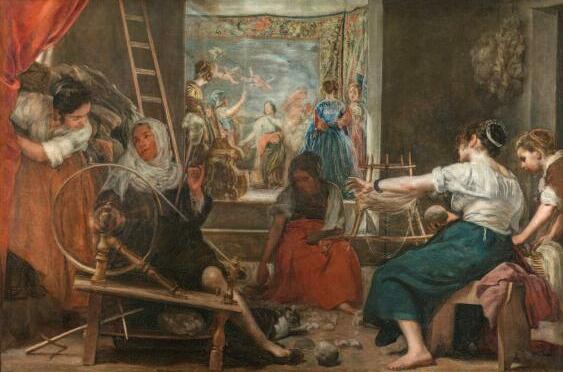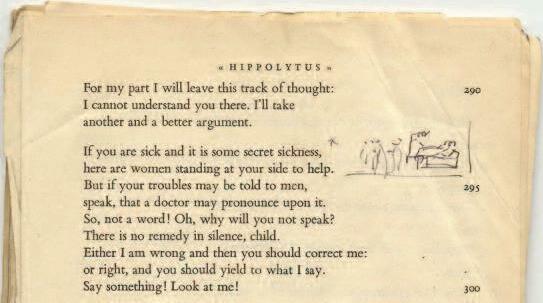
7 minute read
THE TRAGIC VIEW IS THE ONLY TENABLE ONE: ROSEMARIE BECK AND THE POWER OF MYTH
R. Scott Smith Professor of Classics, Humanities, and Italian Studies University of New Hampshire
In the Prado Museum in Madrid there hangs, prominently against a back wall, a painting by the Baroque master Diego Velázquez (1599–1660) called The Spinners. It is a complex and masterful work of art. In the foreground two women spin yarn, an older woman to the left, a younger woman to the right. They are accompanied by three attendants, two helping the spinners and another who seems to be pulling back a curtain to reveal the painting itself. A quiet domestic scene, to be sure, but there is much more to this painting. In the background sits a smaller frame. In it, an armed woman raises her hand aggressively at a young woman, both of whom stand before beautiful tapestries on display. Because this scene is smaller and recessed, a viewer might pass over it but for the fact that it, and not the foreground, holds the key to understanding the whole painting. The armed woman is the goddess Minerva (Athena), who was disguised as the old woman in the foreground. The young woman is Arachne (“Spider ”), the arrogant girl who dared to claim that she could weave better than the goddess and won by weaving a tapestry picturing the gods’ injustices against humanity, especially those against women. In fact, the tapestry displayed behind Arachne on the back wall depicts one of these scenes: Jupiter ’ s forcible abduction of the maiden Europa while disguised as a white bull, a clever “ copy ” of the famous painting by Titian (ca. 1560). But
Advertisement
Arachne’s victory was also her downfall. What Velázquez did not show was what happened next: Minerva beat Arachne until the poor girl hanged herself by a noose and was turned into a spider by the goddess to live out her life as a very different sort of spinner (Ovid, Metamorphoses 6.129–145).
This masterful painting, with its attention to critical points in the narrative, is an appropriate entrée into the works of Rosemarie Beck, a painter and embroiderer of the highest order who also constantly found inspiration in the rich story world of Greek myth. Time and time again, Beck returned, like so many others, to the characters and stories that have resonated in later times in music, art, and literature from Renaissance paintings to Disney ’ s Hercules and the Percy Jackson novels. It is also no wonder that Velázquez’s painting was one of Beck’s favorites. Erudite and allusive, it forces the viewer to engage with the fuller myth and to meditate on the fragility of the human experience.
Velázquez’ painting, then, embodies the tragic worldview of the ancient Greeks and Romans, where human actors, for all their successes and achievements, can be punished justly or unjustly by the gods and the world around them. It was a tragic view that Beck seems to have shared:
I’m distrustful of the bromides prevailing regarding our duty or right to be happy, well-adjusted, self-fulfilling. In fact, from my own experience, the tragic view is the only tenable one. I am an enthusiastic pessimist… (interview with Sawin 2001–2)
Greek myths always had a dark pall hanging over their human actors. Death, rape, incest, loss, and suffering frequently served as the backbone of Greek storytelling, whether in the epic poems of Homer, in the tragic plays that were the intellectual currency of 5th-century BC Athens, or even in the myths parents told their children. There was greatness, too, but even the greatest Greek hero, Heracles (Hercules), lived a life of suffering and torment that ended at the hands of his own jealous wife, and the unstoppable warrior Achilles’ short life was brought to an end though pain and loss loss that he himself caused because of his ego. Greatness and happiness were not interconnected, not by a long shot.
For over thirty years Beck engaged with the stories of Greek myth, often dwelling on one myth for years at a time and producing a prodigious number of drawings, paintings, and embroideries of it. Starting in the 1970s, she took on a series of paintings focused on Orpheus and his wife Eurydice’s tragic death and near rescue the musician Orpheus must have appealed to Beck given her musical background. In the 80s she turned to what I would call an “Ovid Cycle,” which drew on the deeply influential series of myths told in Ovid’s Metamorphoses. This period started with Apollo and Daphne (1981– 84) and continued with Diana and Actaeon (1982– 86), Daedalus and Icarus (1983– 85), and finally Atalanta and Hippomenes (1985– 88). In the late 80s and early 90s she turned to Greek tragedy proper, perhaps reinforced by a trip to Greece in spring of 1990, composing two series of paintings, first on the tragic death of Antigone (1987–1994, from Sophocles’ play
Antigone), then on Phaedra’s suffering and death (1998–2002, from Euripides’ Hippolytus). She had already in the 70s been taken by another tragedy, Shakespeare’s Tempest, exemplified by the brutal tale of Caliban and Miranda, also on display in this exhibition.
Beck’s last great cycle involved the story of Phaedra, the wife of the hero Theseus of Minotaur-slaying fame. Phaedra famously lusts after her stepson Hippolytus, wrestles with that desire, and tries to suppress her dark secret, only to have her wellintentioned but wrong-headed servant reveal it to the young man. Hippolytus, a hunter dedicated to the virginal goddess Artemis, is horrified. The secret out, once-lovesick Phaedra is now mortified and commits suicide but only after writing a letter accusing Hippolytus of attempted rape in an attempt to save her reputation. We can, in fact, see the genesis of Beck’s interest and in the Phaedra myth and its evolution. In her diary of April 9, 1998, she writes:
Now at 74 I’m going officially to begin my Phaedra paintings. These will be my last. I hope I can make several before it’s “curtains.”
“Curtains” is an appropriate metaphor since the Phaedra myth is best known from dramatic plays, not only its earliest incarnation in Euripides’ famous Greek play Hippolytus, but also from Seneca’s Latin version (Phaedra) and Racine’s French adaptation (Phèdre). Although Beck draws from several sources, we are fortunate to have in her archives a well-worn copy of Euripides’ Hippolytus (trans. David Grene in Greek Tragedies, vol. 1, ed. By D. Grene and R. Lattimore), which is annotated and features over ten line-drawn sketches, tableaus representing Beck’s visualization of the text. Perhaps most pertinent is her sketch of the lovesick Phaedra being cajoled by her old handmaid, a scene Beck sketched (Sketchbook #1971 from 1996–7), embroidered, and painted several times:
The composition, with Phaedra surrounded by attendants, is found in Beck’s studies and full-sized paintings (#1750, Phaedra 2001, #1677, Phaedra 1999). In these, Phaedra is facing upwards, ill but alive; in another painting we find a prone Phaedra, dead, her accusatory letter lying at the foot of the bed (#1777, Phaedra 2002) the result of her handmaid’s fateful conversation with Hippolytus (depicted in #1760, Phaedra 2002). Like Velázquez’s Spinners, this scene requires the viewer to engage with the fuller narrative and understand that the young man to the left, attended by his hunting dogs, is Hippolytus, who has rejected her and will later be killed when Theseus (the old man behind Phaedra) calls down curses on his son. Of course, Beck could not help but to add further details tied to the narrative, such as Hippolytus’ dog and Phaedra’s child in the foreground.
Even if Beck thinks about a play in visual terms, then, she is drawn to myths not just for their potential as images but also as tragic narratives. Several times in her journals she refers to “myths and narratives” as inspiration for composing a painting (Aug. 1983, Sept. 6, 1989), which present the artist with striking material to explore the tragic side of human life, where the “complexity, multiplicity, ambiguity represent good in a work of art, for it means you get a different meaning on every occasion” (diary, June 11, 1991).
Greek myth itself is by nature complex, multiplex, and ambiguous, which is the precise reason why it afforded the ancient Greeks and Beck the raw material to explore the human condition, to expose the tensions between right and wrong and between good and evil, and to dwell on the helplessness of humans in a hostile world. Beck certainly saw the same potential:
And in Phaedra the human misery the helplessness of human creatures and the gods screwing them up so. And then there are these heroic women characters. Phaedra is not very nice. Antigone was good. (Samet 2002: 17–18).
Beck constantly seeks the moments that embody a story, and these tend toward the dramatic, certainly reflecting her dramatic training in high school and at Oberlin College: Icarus plummeting from the sky, Antigone being led into the cave to her death, Actaeon spying on the goddess Diana, Orpheus mourning his dead wife or the Thracian women mourning his. In each, the power and universality of Greek myth resonates throughout time emphasized by Beck’s insistence on putting mythical figures in modern dress reminding us that, for all our progress, we still continue to wrestle with the human experience. One final comment from Beck sums it all up:
The question is why paint myths and legends today. And the answer is obvious. … We don’t even have any choice. ... I find myth erupting like a plague for we are not separate from these things. The eternal legends are still in us from Oedipus to Orpheus to the Cross. These are...the perennial undercurrent of existence. They have to do with self and other, with loss and recovery, with stasis and metamorphosis. (quoted in Samet 2010 : 138)
Bibliography readers interested in Beck’s career are invited to consult Martica sawin’s essay, “rosemarie Beck: Never form but forming,” in rosemarie Beck paintings 1965–2001, pp 4–7, available online i am indebted to Doria Hughes, archivist for the Beck foundation (and Beck’s granddaughter), who provided me with entries from Beck’s diary and the transcript of a 2002 interview with Jennifer samet, whose 2010 dissertation (painterly representation in New york, 1945–1975, pp. 127–138) also includes biographical information





